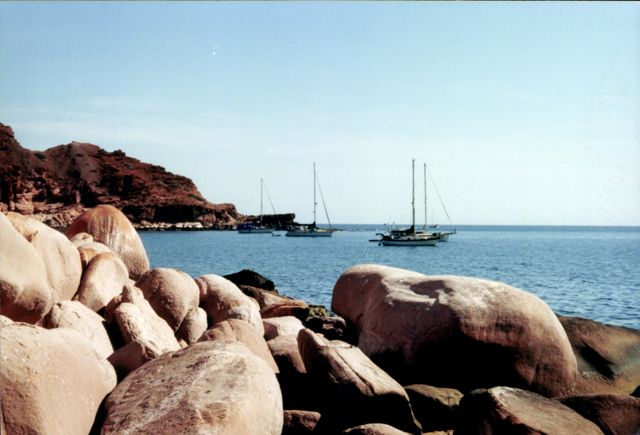Where are we?

Knowing where we are at all times on a boat is a big deal. It is very helpful for avoiding running into things and for crossing oceans and actually arriving at the intended destination. We’ll be carrying paper charts of all the areas we sail, and relying almost solely on GPS to know where we are on those charts. We’ll also have electronic charts which can be very convenient, but not as reliable as paper charts.
Shearwater came equipped with a Raytheon RC530 GPS/chartplotter. This a handy device as it uses a nice size screen to display our position on an electronic chart. When we visited the boat in December, the GPS wasn’t talking to the chartplotter, so it is currently as useful as a box of rocks, but I suspect the issue was low battery voltage. Chris will re-investigate this in April. If we can get the Raytheon working that will be a great, but the Raytheon will continue to have a big drawback. It is located down below at the nav station. Not very useful when you are in the cockpit actively negotiating obstacles and channel markers. To do this properly we need a GPS and would like an electronic chart that we can use in the cockpit.
It turns out there a number of easy ways to tackle the GPS/electronic charts for the cockpit and we will employ a couple of them for redundancy. First, we now have a Garmin 76cx handheld GPS and if we want we can purchase electronic charts for this unit. At the moment, we are holding off purchasing the charts because the screen on the Garmin is really small, we’ll have paper charts, and there seems to be a better option.
If things works as I think they will, our primary navigation tool will be our iPad in a waterproof pouch or case. The iPad will be running the iNavX app which provides the electronic charts, waypoints, and routes. Unfortunately, our iPad does not have 3G, which means it does not have a built in GPS, but that problem is easily solved with a Bluetooth external GPS (Dual XGPS 150). This should give us a very portable, easy to use, large screen, fully functional GPS and electronic charts. With the iPad we can even go one better than the Raytheon or Garmin. With a simple device from Digital Yacht called an iAIS we will have AIS reception wirelessly sent to the iPad and displayed on the iNavX chart along with our position. AIS will allow us to “see” commercial shipping on a chart along with the information regarding the type of vessel, speed, and course. Interestingly, an iPad, iNavX, the XGPS, and the iAIS cost about one-third of the cost of a chartplotter and the iPad which we already had, has a million other uses. Welcome to the new world of marine electronics.
So, three GPS’s, all capable of electronic charting and paper charts sounds redundantly redundant, no? But why stop there? In fact, we will also have both of our iPhone 4’s running iNavX and receiving AIS data. Why? Because there is no additional cost to do this thanks to app sharing and wireless technology and the iPhones have a built in GPS, which may prove more reliable than the iPad.
I should stop now, but I can’t! There is more. On our MacBooks I’ve installed a free charting program called OpenCPN. My sense is that we won’t use this option very often, mostly because we’ll want the laptops safely stored somewhere they cannot get wet or damaged, but if we wanted we could connect to the Bluetooth GPS and the iAIS and have yet another GPS/chartplotter at no additional cost. The real benefit of OpenCPN though, is that it provides a large screen and keyboard for creating waypoints and routes they can be easily transferred to both the Garmin and the iStuff.
Phew! If we don’t know where we are now, then we have a serious problem.
2 comments
Leave a ReplyCancel reply
Sign up to receive blog updates
I am considering using the iAIS, dual xgps150 bluetooth gps, and OpenCPN, along with iNavX. Did you manage to get iais to work the bluetooth gps device? Please email me if you have any advice you could give. Cheers
Richard,
Thanks for the note. At the moment the iAIS and Dual xgps150 are still in their boxes. I’m flying to the boat in 2 weeks and I’ll fire everything up and report on how it goes.